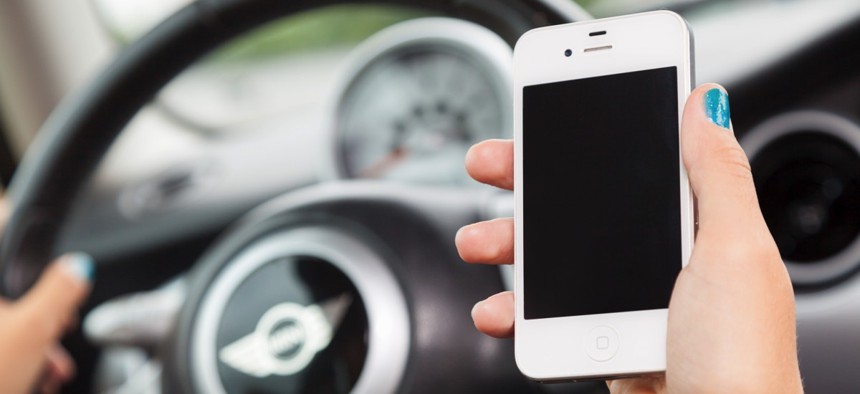The ‘Textalyzer’ Fills an Important Need for Law Enforcement. But Does It Violate Privacy?

In New York state, some lawmakers want to equip police with technology to check if a mobile device was used right before a car crash, but opponents say that gives them too much power.
Legislation sanctioning police use of the “Textalyzer” in suspected cases of distracted driving has raised privacy concerns as it works its way through the New York State Legislature.
The technology tests mobile devices for use in the moments leading up to a crash and was designed by Israeli security firm Cellebrite—a company initially thought to be helping the FBI crack an iPhone used by one of the suspects in last December’s terrorist attack in San Bernardino, California.
Supporters of the law enforcement tool, who say it can be a powerful resource in suspected distracted driving cases much in the same way a breathalyzer is used for suspected drunk drivers, say it’s noninvasive.
“The privacy of the content and data will be protected. They will not have access to that,” Assemblyman Felix Ortiz, a bill sponsor, told Route Fifty in an interview, referring to law enforcement personnel. “It only determines whether the cellphone was used at the time of the crash and was it a message that went out. It won’t check if it was a picture.”
In 1996, Ortiz, the self-described “father of the cellphone ban,” introduced New York’s first bill outlawing the use of handheld devices while driving after witnessing an accident caused by someone talking on theirs. A cellphone-while-driving ban was eventually passed by New York lawmakers in 2000.
Ortiz said privacy concerns are normal with this type of legislation, but New York Civil Liberties Union Executive Director Donna Lieberman doesn’t think they’re being taken seriously enough.
“Distracted driving is a serious public safety concern, but this bill is ill-conceived and misguided, and fraught with legal and practical problems. This proposal appears likely to impute suspicion and guilt for a wide range of lawful activity, and to invite cops to seize phones without justification or a warrant,” she said in a statement. “There are existing legal channels for law enforcement to access a phone or phone records if they have grounds to suspect distracted driving has occurred, rather than field-testing every fender bender.”
But, as Chappaqua, New York, resident Ben Lieberman (no relation to Donna Lieberman) found when his 19-year-old son died following a crash in the summer of 2011, those channels are often underused and inefficient. Lieberman’s son was a backseat passenger, and the driver at fault said he fell asleep at the wheel though the father suspected otherwise.
“Police rarely look at the phones at all,” Ben Lieberman said. “It’s not their fault because it’s not police protocol.”
The threat of lawsuits and lack of training in the nuances of smartphones are other deterrents, he added.
It took six “agonizing” months to subpoena the driver’s phone records in a civil lawsuit, Ben Lieberman said, which showed he had been using his device on the ride. But the crash occurred in a dead zone, so distracted driving couldn’t be labeled as the cause.
Since then, Ben Lieberman co-founded Distracted Operators Risk Casualties and has advocated for stricter enforcement against distracted driving. That resulted in a legislative proposal called “Evan’s Law,” which is designed to comply with the unanimous 2014 U.S. Supreme Court Riley v. California decision, which ruled that police can’t search cellphones without warrants.
“What we’re trying to do here, as a result of police not being able to take the cell phone away from the driver because the law doesn’t allow it, is make [the Textalyzer] more accessible for law enforcement to procure,” Ortiz said.
Through research, Ben Lieberman said he learned just how destructive distracted driving is—six times more dangerous than drunk driving, and yet 67 percent of drivers still report engaging in the behavior. Under New York law, those found guilty of texting while driving can be fined only $50 to $450. And without a device like the Textalyzer, distracted driving accidents will remain underreported, advocates contend.
Ben Lieberman said he recognizes that “phones carry very personal information,” and the Textalyzer’s developers say—in addition to photos—conversations, contacts, numbers and app data remains private.
The bill itself is modeled after the state’s breathalyzer law because “an impairment is an impairment,” he said, granting officers implied consent where distracted driving is suspected. If the driver refuses to be “textalyzed,” they won’t go to jail but will lose their license.
Introduced in both houses of the New York State Legislature, the bill was approved by the Senate Transportation Committee and passed on to the Finance Committee and is also assigned to Assembly’s Transportation Committee.
New York’s legislative session ends June 16, so the timeline for the bill’s passage is a “bit daunting,” Ben Lieberman said.
“We think that it has to start out in the state of New York,” he said. “New York is more aware of the problem than other states.”
Ortiz agreed, saying all eyes were on the Empire State when lawmakers passed New York’s handheld cellphone ban 16 years ago.
“Every six years you might be able to do a type of bill of this magnitude,” he said. “New technology is coming out all the time.”
Dave Nyczepir is a News Editor at Government Executive's Route Fifty.
NEXT STORY: Los Angeles City Controller Unveils New Economic and Demographic Data Portal






